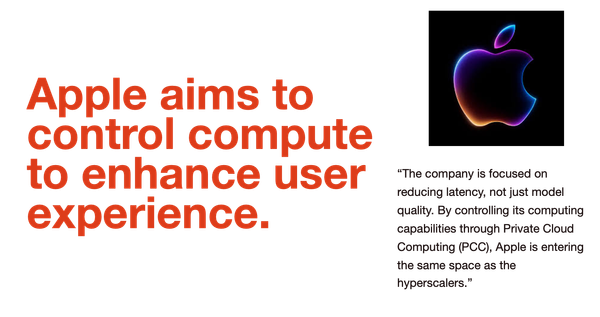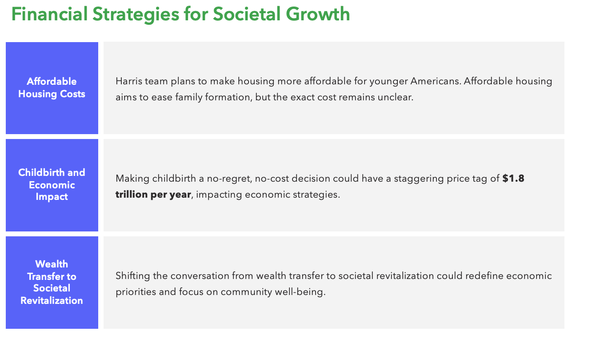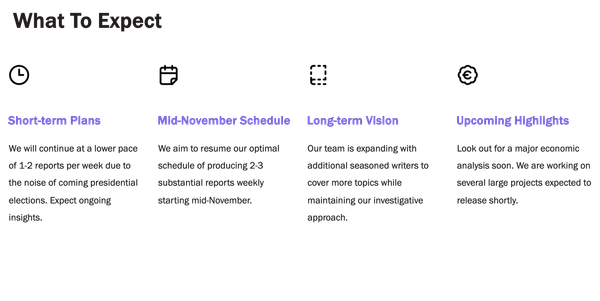NVIDIA: A Canary in the Coal Mine
Some investors are cashing out.

NVIDIA, the darling of Wall Street and Silicon Valley for its dominance in the AI chip market, may be facing more significant hurdles than CEO Jensen Huang has publicly acknowledged. Our extensive conversations with insiders, analysts, and customers reveal a concerning outlook that contrasts sharply with the company's current market enthusiasm.
Strategic Insights Report is a reader-supported publication. To receive new posts and support my work, consider becoming a free or paid subscriber.
Key Findings:
- Revenue projected to decline starting in 2026
- Evidence of double-ordering by at least two of NVIDIA's top five customers
- Training needs expected to taper off within the next 18 months
- Buy side analysts not convinced in current valuation, and starting to cash out
While NVIDIA's present position is formidable, with Huang stating, "Our demand is greater than our supply," the long-term outlook is less certain. Insider discussions suggest that the company's near-term growth could peak by mid-2025, followed by a potential cyclical downturn in revenue beginning in 2026.

A major concern stems from NVIDIA's limited product roadmap visibility. A procurement executive from one of NVIDIA's top-five hyperscaler customers expressed frustration: "We can't design a datacenter using Blackwell-II. We don't know what it would look like. Besides, I am buying Blackwell for the next 5 years, not just the next year." This statement highlights a significant disconnect between NVIDIA's short-term planning and its clients' long-term needs.
Further complicating the picture is evidence of substantial double-ordering among NVIDIA's top customers. A senior procurement executive candidly admitted, "We certainly want to be given the most favored nation treatment, so certainly, we are ordering more than we have use for. Some of it is that we think we'll grow into it, but we are also being asked by the CEO to order well ahead of the need."
This practice of over-ordering, combined with the expected tapering of AI training needs within the next 18 months, could lead to a sudden drop in demand, potentially catching NVIDIA off-guard.
These revelations paint a picture of a company at a crossroads. While NVIDIA currently rides high on the AI boom, the insights from our sources suggest that maintaining this trajectory beyond 2025 may prove challenging. As the tech world watches, the question remains: Can NVIDIA navigate these looming challenges and sustain its meteoric rise, or will it face a significant slowdown in the post-AI gold rush era?
Long-Term Concerns and Industry Perspectives
Despite the current success, there's an unmistakable undercurrent of concern regarding long-term prospects. Insiders close to Huang suggest he is deeply introspective about NVIDIA's future trajectory. Growth beyond 2026 will need another large inflection, something Jensen is worried may never come. "Jensen is worried about what comes next. The company is in overdrive, but there's this strange undercurrent of fear that we've fired our last shot," confided one anonymous insider.
Buy-side analysts have tempered their optimism on NVIDIA. We spoke with the CIO of a prominent hedge fund who revealed a significant reduction in their NVIDIA holdings—cutting their position by 50% this week, with plans to halve it again over the next year. "Our investment in NVIDIA has quadrupled, and we're grateful to Jensen for his leadership. However, it's time to safeguard our capital. We're scaling back our investment to our original stake and hoping that the share prices remain stable," the CIO explained.
This rapid pace of technological evolution in AI presents a paradox for NVIDIA. While currently operating at peak capacity to meet demand, there is a pervasive concern about maintaining its edge in innovation. Huang previously articulated this challenge: "The challenge is AI is not slowing down. The research community didn't slow down either. They continue to deliver faster, better, smarter neural networks."
A veteran chip analyst commented, "NVIDIA's current success is reminiscent of the crypto mining boom. We all know how that ended. The AI boom might have a longer tail, but it's not infinite." Another customer, a CTO at a major tech company, stated, "We're stockpiling NVIDIA chips now, but we're also investing heavily in alternatives. By 2025, we expect to have more options on the table."
Drawing a parallel to another industry giant, a senior NVIDIA executive likened the company's situation to that of Boeing, noting the similarity in having products backordered for immediate delivery. However, he pointed out a crucial difference: NVIDIA's roadmap is comparatively short-lived given the rapid pace of the tech industry. "But given how fast this industry changes, that roadmap only goes up to 2 years. After that, it's anyone's guess," the executive admitted, highlighting the uncertainty that clouds NVIDIA's long-term strategy and product development plans.
Industry analysts echo this sentiment of robust short-term demand but questionable long-term stability. One noted a strategic reduction in their investment, predicting an oversupply and subsequent price cuts by mid-2025. A prominent Wall Street analyst added, "NVIDIA's current valuation assumes perpetual growth. But history teaches us that no tech company maintains dominance forever. The question isn't if NVIDIA will face a slowdown, but when."
A former NVIDIA executive commented on the situation, saying, "Jensen's brilliance lies in his ability to anticipate the future. However, this time, the challenge may be too great even for him." A consultant from an Executive Search firm, specializing in CEO recruitment, shared, "Founders often believe in their eternal effectiveness, but eventually, they reach a limit. In industries where the founder has pioneered a new sector, they tend to become less effective after the age of 60, although they usually don't step down until they are over 70. Considering the highly technical and analytical nature of the company that Jensen leads, one wonders if he will be up to the challenge three years from now."
NVIDIA - a History Lesson
Even though our readers are more educated than the most, we thought we will take a sideway walk and go through the history of NVIDIA briefly.
In its early years, NVIDIA was laser-focused on computer graphics. As Jensen Huang stated in 1999, "All of us at NVIDIA are fully committed to staying intensely focused on execution and continue our march to become the dominant supplier of desktop PC graphics." This dedication paid off. Huang proudly declared, "NVIDIA's commitment to uncompromising performance at a consumer price has energized the formation of a complete infrastructure for 3D entertainment, including product, technology, and content."
However, Huang's ambition led him to explore beyond desktop graphics. He articulated NVIDIA's broader mission in a 2008 interview with Charlie Rose: "Our holy grail as a company is to make a difference, to have created technology that surprises you and delights you."
The Mobile Revolution and Searching for the Next Big Thing
The dawn of the smartphone era in the late 2000s presented a new frontier for tech companies, and NVIDIA was no exception. As the mobile market exploded with the introduction of the iPhone and the subsequent rise of Android devices, Jensen Huang saw an opportunity to diversify NVIDIA's portfolio beyond its traditional PC graphics stronghold.
In 2011, NVIDIA found itself at a crossroads. The company had built its reputation on high-performance graphics processing units (GPUs) for personal computers, but the rapidly evolving tech landscape demanded adaptation. Sensing the shift, Huang made a bold proclamation: "We used to be a PC graphics company — only PCs, only graphics. We have reinvented Nvidia. We are well positioned to go after a market opportunity that is sixfold the market opportunity of the Nvidia you knew from the past."
This statement was specifically referring to NVIDIA's foray into mobile graphics. The company had developed its Tegra line of mobile processors, aiming to capture a slice of the burgeoning smartphone and tablet market. Huang's optimism was palpable, as he envisioned NVIDIA's technology powering a new generation of mobile devices.
However, the mobile graphics market proved to be a challenging arena. Despite initial enthusiasm and some notable wins, such as powering the graphics in the Nintendo Switch gaming console, NVIDIA faced stiff competition from established mobile chip makers like Qualcomm and Apple's in-house designs.
An industry analyst, reflecting on this period, noted, "NVIDIA's mobile ambitions were a classic case of a company trying to pivot. They saw the writing on the wall for PC-only players and made a bold move. But the mobile market was already crowded and had different dynamics than PC graphics."
A former NVIDIA executive, speaking anonymously, added, "The mobile push was Jensen trying to find the next big thing. We knew we couldn't rely solely on PC graphics forever. It was a necessary exploration, even if it didn't pan out as we had hoped."
The mobile venture, while not as successful as initially envisioned, demonstrated NVIDIA's ability to adapt and explore new markets. It also highlighted Huang's propensity for making big bets on emerging technologies – a trait that would serve the company well in its later pivot to AI.
As it turned out, the "sixfold" opportunity Huang spoke of didn't materialize in mobile graphics. Instead, it would come years later in the form of AI and data center GPUs. This experience in mobile served as a valuable lesson for NVIDIA, teaching the company about the challenges of entering established markets and the importance of timing in technological shifts.
A current NVIDIA employee reflected, "The mobile era taught us resilience. It showed that not every bet pays off, but you have to keep placing them. That mindset was crucial when we later saw the potential in AI."
This period in NVIDIA's history underscores the constant need for tech companies to evolve and search for new growth avenues. It also highlights the challenges of predicting where the next big opportunity will come from – a challenge that NVIDIA continues to grapple with as it looks beyond its current AI-driven success.The AI Revolution Begins
The AI Era Unfolds
The year 2012 marked a pivotal moment when Alex Krizhevsky used NVIDIA GPUs to accelerate deep learning. By 2016, Huang was ready to declare AI as the next frontier: "This will be the next computer revolution and also the new industrial revolution."
He outlined NVIDIA's role in the AI ecosystem:
"The GPU, deployed in data centers, will be in charge of responding to these requests through inferencing. End devices will be able to infer and learn from experience, which enables them to better perform tasks and become smart devices with sensing, understanding and learning capabilities." Huang also highlighted GPU superiority for AI: "The CPU is based on traditional computation architecture, not tailored for AI. Tesla P4 and P40 are superior to the most advanced CPU in terms of both performance and power efficiency."
As AI adoption accelerated, Huang's vision became reality. Quite presciently, Huang had announced, "Deep learning software designs itself so that computers will learn from experience and become smarter."
By 2020, Huang was confident in NVIDIA's position: "A100 adoption is just starting. I mean we're going to see several couple of years of continued growth yet ahead of us, well, as AI gets adopted in clouds and industries."
He predicted widespread AI adoption: "In the future, all of these industries, whether you're in medical imaging or in lawn mowers, you're going to have data centers that are hosting your products just like the CSPs."
The release of ChatGPT in 2022 further validated Huang's vision. As he had stated earlier, "The deep recommendation systems, the natural language understanding breakthroughs, the conversational AI breakthroughs, all happened in this last year."
In 2024, NVIDIA is expected to surpass $100 billion in revenue with an 80% margin. In Q1 of 2024, the company reported a 262% increase in growth over the first quarter of 2023 in its latest quarterly announcement. This level of year-on-year growth and profit margins is unparalleled in the industry. Yet, there are signs of trouble.
NVIDIA's Challenges and Opportunities
Despite NVIDIA's dominance in the AI chip market, the company faces significant challenges looking ahead. A large part of its success can be attributed to Jensen Huang's visionary leadership. An insider noted, "Jensen is the one who steers NVIDIA. We may have the smartest engineers, but he is our principal product visionary. The real question is whether he can lead the charge on innovation for another 12 years, as that is the time required to develop a new idea and bring it to market."
At 61, Huang remains upbeat about NVIDIA's prospects, having expressed his ambition to mold NVIDIA into the premier computing entity of the AI era. This vision has propelled the company’s rapid ascent in recent years, yet doubts remain regarding its capacity to sustain this growth.
A major concern is the looming saturation of the AI training market, akin to the fluctuations seen in cryptocurrency mining. Analysts worry that after the initial AI infrastructure setups, demand might plummet, positioning NVIDIA similarly to traditional CPU giants like Intel and AMD, who primarily compete over replacement and upgrade business within data centers. "Once the initial AI wave subsides, NVIDIA may find itself vying for replacement dollars, akin to Intel and AMD, in a mature, slower-growth market," an analyst explained.
Despite a solid current order book covering the next two years, this potential shift from a booming to a commoditized market poses significant risks for investors and industry watchers. Double orders from top customers aiming to secure their near-term needs underscore this anxiety. "We're investing billions in new data centers that rely on NVIDIA's tech. These are long-term investments, not just for the next two years," revealed executives from two top-5 NVIDIA customers.
Furthermore, the AI chip market, while currently less competitive, is poised to intensify within two years, especially around inference capabilities. As competitors, both established tech giants and emerging startups, intensify their focus on AI chip development, NVIDIA could face mounting pressure on its market share and margins.
The cyclical nature of the semiconductor industry, typically marked by phases of growth followed by downturns, adds another layer of complexity. "We're in the second year of growth, but history shows this is usually followed by a downturn," noted a buy-side analyst, highlighting the critical need for strategic cycle management to preserve NVIDIA's financial well-being.
Despite these challenges, NVIDIA's innovation prowess and its robust ties with key AI developers and data center operators lay a strong groundwork for future growth. The expanding use of AI across various sectors also presents fresh avenues for NVIDIA's technologies.
As NVIDIA confronts these upcoming tests, Huang's strategic foresight and adaptability will be pivotal. His knack for steering the company through technological shifts has been instrumental to NVIDIA's achievements. "Jensen has always aimed to make a significant impact, crafting capabilities that surprise and delight. The pivotal question is whether he can orchestrate another industry transformation as he moves into his mid-60s," commented an industry observer.
Investors base their decisions not on the present but on the future. While NVIDIA currently shows robust revenue growth, the expected slowdown by 2025 marks a vital period of transition. This has led several investors we've spoken with to begin cashing out. The coming years will challenge Jensen Huang's capacity to drive innovation and foresee technological shifts, essential for keeping NVIDIA at the forefront of the AI industry. The company's valuation may prove challenging to uphold if Huang and his team struggle to effectively manage these impending challenges.



